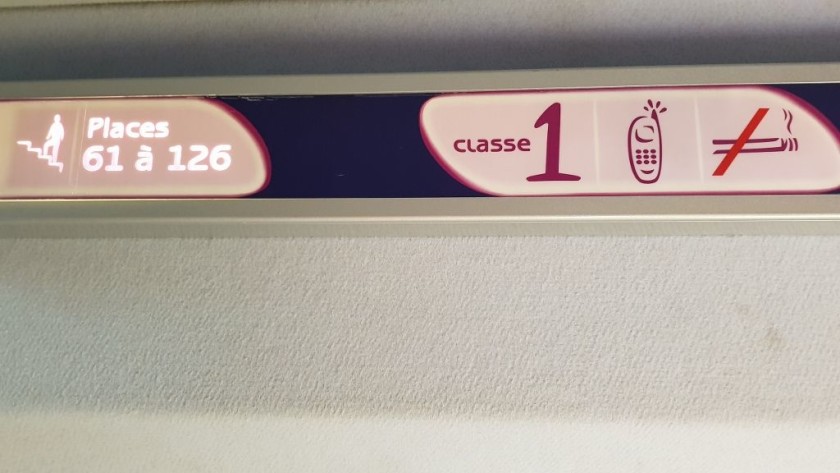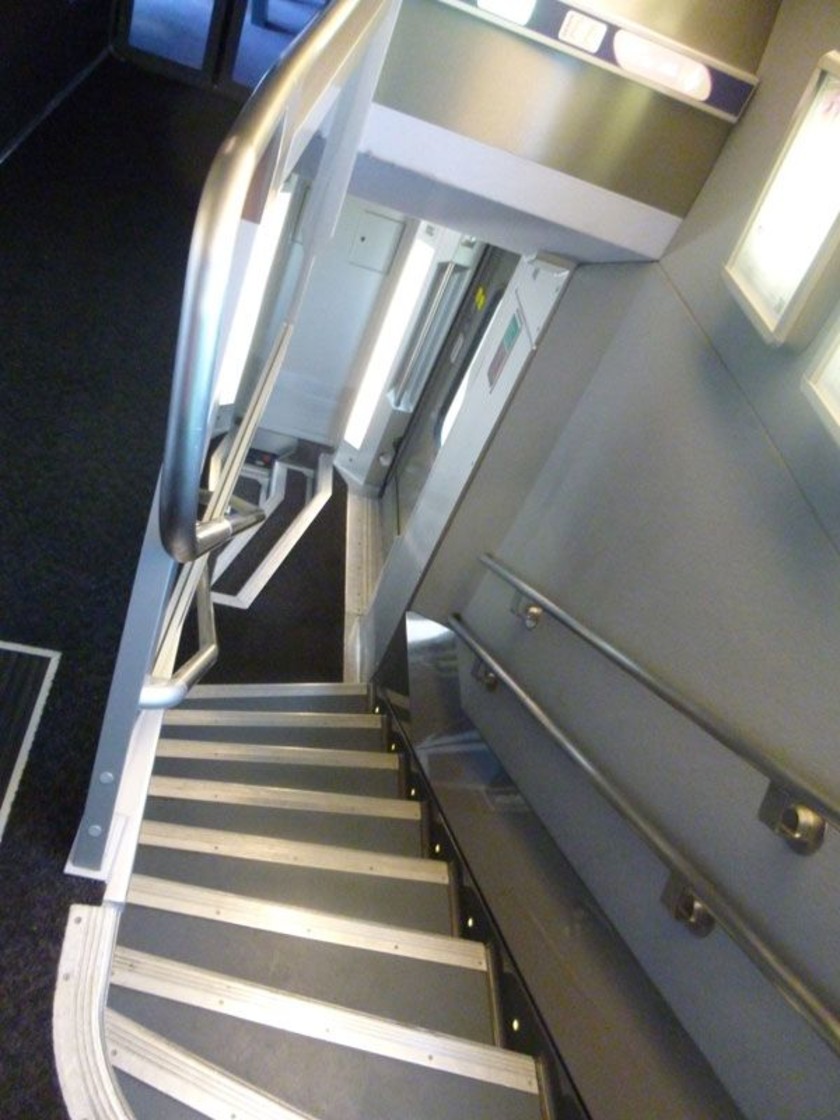Content

TGV InOui France - Espagne
Welcome to the guide to taking one of the high speed trains operated by SNCF on the routes between France and Spain.
Share
At a Glance
Travel Pass Supplement
Rail Pass Reservation Fees
Reservations
Compulsory
Time of Day
Day
Catering
Food services available
Bar (sandwiches, snacks, salads)
Accessibility
Accessing the train
Wheelchair Spaces
Train Specification
Attributes of the train
High Speed (total journey)
Double Deck
Has a Conductor
Country
Which country these trains operate in.
France
Spain
Travel Passes
Eurail
InterRail
On Board
Première/Primera
Perks
WiFi
A complimentary WiFi portal is available throughout this train.
Power Socket
The power sockets on this train are compatible with standard E.U. two point plugs.
Seconde/Segunda
Perks
WiFi
A complimentary WiFi portal is available throughout this train.
Power Socket
The power sockets on this train are compatible with standard E.U. two point plugs.
Good to know info
ShowMeTheJourney has anticipated what questions are most often asked about travelling on these TGV trains and answered them below.
If you can't find the information you are seeking, you can ask a question by using the Travel Planning Service.
How fast does the train travel?
These trains have a theoretical top speed of 320 km/h (198 mph), but on the high speed lines, they typically travel at up to around 300 km/h.
Are seats allocated when booking tickets?
Yes.
Can specific seats be selected from a seating plan?
This is possible when booking Premiere, or Business Premiere tickets on SNCF Connect.
See the ShowMeTheJourney guide on how to book on SNCF Connect.
Can I choose forward facing seats?
Yes - most of the seats can be rotated by station staff prior to the commencement of each jourmey.
So when booking tickets on SNCF Connect it shows forward facing seats as a default (but this can be switched).
See the ShowMeTheJourney guide on how to book on SNCF Connect.
Do Eurail / InterRail Pass users need to make reservations?
Yes - See the guide to using rail passes in France and / or the guide to travelling by train in Spain.
Though what's new is that flat-rate fees are now charged regardless of distance.
However, the AVE trains are cheaper for rail pass users than taking the TGV services between Spain and destinations in France between Perpignan and Nimes, which include Beziers, Narbonne and Montpellier.
What catering is available on the train?
The trains have a bar/ bistro service - see the Catering section below for more info.
Are power sockets available?
Yes - for standard E.U. 2-point plugs
Is Wi-Fi available?
Yes - and more info on how to connect on the French part of the journey is available here.
What is the luggage policy?
You must be able to carry all your luggage alone at one time.
You can take either:
2 suitcases + 1 hand luggage
OR
1 suitcase + 1 special baggage + 1 hand baggage
Your hand luggage can measure a maximum of 40 cm x 30 cm x 15 cm.
Your suitcase can measure a maximum of 90 cm x 70 cm x 50 cm
Your special luggage (musical instrument, bicycle under cover, folded bicycle, scooter) can measure a maximum of 130 cm x 90 cm. Bicycles, musical instruments, and snowboards, skis, must be in a labeled cover.
More info is available on the SNCF Connect website.
Are wheelchair spaces available?
Yes, they are housed on the lower deck in a Premier / 1st class coach.
More info is available on the SNCF Mobility Services guide.
Can non-folding bicycles be taken on board?
Bike racks are available but spaces must be reserved prior to boarding.
When booking tickets on SNCF Connect you can add a bike symbol to the search, so will then see which departures have bike spaces available - taking a bike on board requires an additional ticket.
See the ShowMeTheJourney guide on how to book on SNCF Connect.
What’s also worth knowing is that you can’t book Premiére/1st class tickets for journeys by these trains if you want to travel with a bike; presumably because the bike storage on these trains isn’t adjacent to the Premiére Class seating areas.
Can dogs be taken on board?
One dog per person, non guided dogs are charged €7, smaller dogs must travel in containers, larger dogs must be muzzled.
More info is available on the SNCF Guide.
Renfe-SNCF (TGV) travel guide:
The high speed train service that crosses the France/Spain border to provide international daytime train journeys to/from Barcelona and Madrid is branded 'en coopéreation RENFE - SNCF'.
Not the most memorable name of a train service, they used to be known as 'Elipsos' services and SMTJ wishes they still were.
However, the name reflects the spirit of co-operation French railways (SNCF) and Spanish railways (RENFE) share the provision of the trains.
The French trains used for the service on the Paris - Barcelona route are 'EuroDuplex' trains - international versions of the double-decker TGV Duplex trains.
On the OTHER high-speed routes between France and Spain, Spanish AVE trains are normally used.
Reservations & Using Rail Passes:
Seats will automatically be assigned when booking tickets for journeys by these trains.
Rail pass users will need to have made reservations prior to boarding.
The comparatively expensive fee for doing so depends on the distance you will be travelling, though the cost is likely to be cheaper than buying a separate ticket.
The price show above is for Paris - Barcelona journeys, but the fee will be less for shorter journeys such as Montpellier - Barcelona.
Something to note is that your rail pass only has to be valid in France OR Spain.
So if you will be travelling with a 'one country pass' valid for France, you can use it to add Barcelona to your itinerary.
Boarding:


Before arriving on the platform/track, check your ticket and find number of the coach in which your reserved set is located.
Then use the info screens on the platform/track, to check which zone you should wait in, for easy boarding into your coach.
The coach/carriage numbers can be hard to spot as they are on the electronic info panel set into the body work of the train by the door.
Each carriage/coach only has one door. It won’t open automatically there will be a button to the right of the door (when exiting the train you will also need to use the button to open the doors)
Whether you have luggage or not keep your ticket you where you can access it easily, so that you can check your seat number as you enter the seating saloon.
The coach numbers aren't included on the interior, so try and take your time and check that you are boarding into the coach in which your reserved seat is located.
Keep your ticket where you can access it easily, so that you can check your seat number as you enter the seating saloon.
As you step on to the train, look out for the easy to miss signs, located above your head, that indicate which seat numbers are on the lower and upper decks.
The sequence of numbers can seem illogical, so take your time.
The seat numbers are above the windows, by the lights.
What you won’t see is any indication of the stations between which the seat is reserved for, all you have to do is look for the seat numbers and match it to the seat number on your ticket.
If you don't have luggage with you, hang back and be amongst the last passengers to board.
All seats are reserved, so you won’t risk having no seat to travel in, and you can avoid being caught up in the scramble for luggage space.
Managing luggage:
The maximum luggage allowance = 2 suitcases/large bags + item of hand luggage per person.
If you are travelling 2nd class and have large items of luggage, don’t be tempted to locate your seat first, and then work out where to stow your luggage, because the space for stowing bagsis fairly limited within the seating saloons.
Only small suitcases, backpacks etc can on the above seat racks.
Though medium size bags will fit in the space between some of the seats.
In the 2nd class seating saloons there are two luggage racks.
However, on both the lower and upper decks you have to walk by the MAIN luggage racks to access the seating saloons.
If there's space on these racks then the advice is to make use of it - if you're prepared to accept that you won't be able to see your bags from your seat.
If you've entered by the door to the coach in which you seat is located, then the smaller luggage rack will be at the far end of the seating saloon.
However, if you'll be boarding an already busy train you'll be lucky to find space on this rack.
The lower decks have more areas in which bags can be stowed away, but if you are travelling 1st class avoid utilising the space set aside for wheelchair users.
There is generally more space in which to stow luggage in 1st class, in the 1st class upper deck there are racks in the middle of the seating area that can accommodate large items.
On Board:

In addition to sockets by the seats, power sockets are also available in the platforms/vestibules between coaches, you are encouraged to use these spaces between coaches to make mobile calls.
Staircases link the lower and upper levels and there are toilets on both levels.
However, if you want to access the bar counter, then it’s easier to move through the train at the upper level, as the serving counter is on the upper deck.
The upper deck offers better views, as they enable passengers to see over the sound barriers that line much of the track, but if you are tall and sat by the window on the upper deck, take care not to bang your head on the ceiling when you leave the seat.
When booking tickets target the lower deck if you have luggage and/or if you are tall, the lower deck can feel more spacious.
Catering:
There is no trolley service on these trains so you will need to go the bar coach if you want to purchase food and drink.
Take care with food and drink, particularly un-opened bottles and drinks in cups and glasses. When the trains corner at high speed, drinks and food can fly off the table
Bicycles:
Non-folding bikes must be disassembled and packed into a travelling case measuring no more than 120cm x 90cm.
This second version of ShowMeTheJourney is exciting and new, so we are genuinely thrilled that you are here and reading this, but we also need your help.
We’re striving not to let anything get in the way of providing the most useful service possible, hence a facility has been set up with DonorBox which can be used to support the running costs and make improvements.
Instead of advertising or paywalls, your financial support will make a positive difference to delivering an enhanced service, as there’s a lot of ideas which we want to make happen.
So if you have found the info provided here to be useful, please consider saying thank you.

This is one of more than 100 train travel guides available on ShowMeTheJourney, which will make it easier to take the train journeys you want or need to make. As always, all images were captured on trips taken by ShowMeTheJourney.



